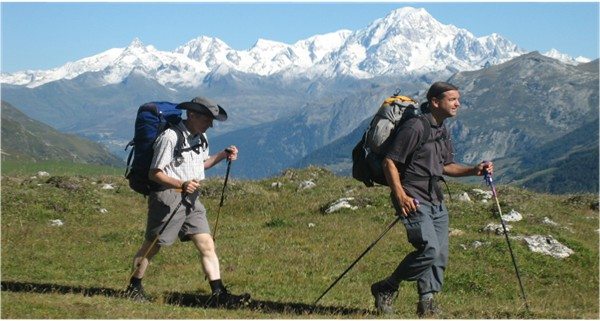In this post, we are going to talk about walking poles, the pros and cons, and whether you should use them.
The Pro’s of using walking poles
- They reduce the stress on your knees by slightly softening the impact that you take with each step. This is even more apparent when going down hill. A 1999 study in The Journal of Sports Medicine found that trekking poles can reduce compressive force on the knees by up to 25 percent.
- They give you stability over rough terrain. Using poles help you balance on uneven ground by giving you more points of contact with the ground. This can help reduce strain on your ankles.
- Poles give you more traction on slippery surfaces like mud or snow.
- You can use them to check the ground ahead for bogs and puddle depths.
- Pointing at things in the distance is a popular hobby of most ‘pole walkers’.
- They can be useful in First aid and emergency situations. As well as having uses like a tent pole or camera stand.
- They can help you walk faster as you use your arms to propel you forwards.
- Great for clearing the path or holding back brambles as you walk by.
- You can also draw maps on the ground and point at small flowers and insects without bending over.
The cons of using walking poles
- They are cumbersome and annoying to have in your hands sometimes. It can make simple tasks harder like taking your bag off or setting a bearing as they fly around from your wrists.
- They are more weight to carry and easily snag on things when attached to your bag. That’s if you can make it stay on your bag in the first place!
- Some say that they can be counter productive by people relying on them too much and people’s balance and stabilisation become weaker over time.
- They use more energy by using your arms more.
- Poles are noisy. Or they can be especially when you don’t use the rubber tips on hard surfaces, But who’s going to bother swapping all the time anyway.
- They can get stuck in between rocks or in bogs, making it more effort pulling it out.
- They cost money
- It’s just not cool to use poles

There are a lot of arguments to both sides of the debate but its really a very personal thing. You need to weigh the pros and cons out for your requirements.
From speaking to people about using poles the is one thing I couldn’t miss. That’s the fact that most people convert to using poles and not many converted back. It seems to be that once you start using them, they become habit.
Some people like to have the poles for the extra stability and confidence on rough terrain whereas some people just don’t like to have them in their hands.
My advice is if you choose to use them then use them wisely. Poles are very useful on rough terrain and can significantly reduce pain in your joints when going down hill. However when on easy terrain or rocky terrain then they will use up more energy than it is worth.
So pick when you need your poles and stow them away when you don’t really need them.
When on tricky ground, take your wrist straps off so you can drop your poles easily and avoid the straps huring your wrists.
Should I use 1 pole or 2?

If you use just one pole with one arm then you can become a bit lop-sided in your walking. It is generally recommended that if you use one pole then you should make sure you swap hands to avoid this.
That being said, having one pole can be an advantage. In some conditions where you may just need a pole every now and again then having one pole loose in your hand so that you can swap hands easily, leaving the other hand free for balance.
Most people however will prefer to use two poles so you get the full benefit of knee support and balance.
How to use walking poles
- First off make sure the pole is the right length. Your elbow should be at 90 degrees with the spike on the floor.
- When using the wrist straps, carry the weight of the pole in the straps. This will enable you to have a looser grip on the pole, preventing sore wrists over time.
- Make sure the pole is properly tightened before use.
- Place the bottom of your pole very slightly behind you on each step. This will ensure you are only getting forward propulsion from your arms.
- Get into a rhythm with your poles and your step for easy walking.
I hope this helps you decide on poles.
As always, any questions, ask below

